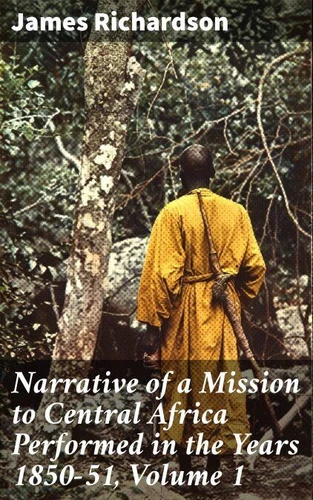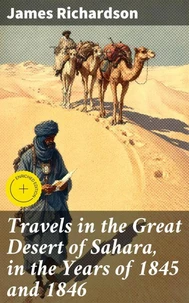Narrative of a Mission to Central Africa Performed in the Years 1850 - 51, Volume 1. Journey through Colonial Central Africa
Par :Formats :
Disponible dans votre compte client Decitre ou Furet du Nord dès validation de votre commande. Le format ePub est :
- Compatible avec une lecture sur My Vivlio (smartphone, tablette, ordinateur)
- Compatible avec une lecture sur liseuses Vivlio
- Pour les liseuses autres que Vivlio, vous devez utiliser le logiciel Adobe Digital Edition. Non compatible avec la lecture sur les liseuses Kindle, Remarkable et Sony
 , qui est-ce ?
, qui est-ce ?Notre partenaire de plateforme de lecture numérique où vous retrouverez l'ensemble de vos ebooks gratuitement
Pour en savoir plus sur nos ebooks, consultez notre aide en ligne ici
- Nombre de pages205
- FormatePub
- ISBN859-65--4752387-1
- EAN8596547523871
- Date de parution22/08/2023
- Protection num.Digital Watermarking
- Taille797 Ko
- Infos supplémentairesepub
- ÉditeurGOOD PRESS
Résumé
In 'Narrative of a Mission to Central Africa Performed in the Years 1850-51, Volume 1, ' James Richardson captures the profound complexities of his expedition through richly descriptive prose and meticulous attention to detail. The book offers a vivid tapestry of the landscapes, cultures, and challenges encountered during his mission to explore and promote commerce and Christianity in Central Africa.
Richardson's literary style intertwines travel writing with anthropological observations, reflecting the Victorian fascination with exploration and its ethical implications, while offering a pre-colonial perspective on Africa that transcends simplistic narratives often found in contemporaneous accounts. James Richardson, a noted English explorer and scholar, was motivated by a combination of personal conviction and intellectual curiosity during his mission.
His background in the merchant service laid the foundation for his understanding of trade dynamics, while his literary ambitions drove him to document not only his travels but also the rich cultural tapestries of the regions he visited. Richardson's commitment to the advancement of knowledge about Africa is evident in his nuanced portrayals of its peoples, challenging prevailing stereotypes of the period.
This volume is a recommended read for those interested in the intersections of exploration, commerce, and cultural encounters in 19th-century Africa. Richardson's engaging narrative not only informs but also invites critical reflection on the implications of Western intervention; it is an essential contribution to the canon of African exploration literature.
Richardson's literary style intertwines travel writing with anthropological observations, reflecting the Victorian fascination with exploration and its ethical implications, while offering a pre-colonial perspective on Africa that transcends simplistic narratives often found in contemporaneous accounts. James Richardson, a noted English explorer and scholar, was motivated by a combination of personal conviction and intellectual curiosity during his mission.
His background in the merchant service laid the foundation for his understanding of trade dynamics, while his literary ambitions drove him to document not only his travels but also the rich cultural tapestries of the regions he visited. Richardson's commitment to the advancement of knowledge about Africa is evident in his nuanced portrayals of its peoples, challenging prevailing stereotypes of the period.
This volume is a recommended read for those interested in the intersections of exploration, commerce, and cultural encounters in 19th-century Africa. Richardson's engaging narrative not only informs but also invites critical reflection on the implications of Western intervention; it is an essential contribution to the canon of African exploration literature.
In 'Narrative of a Mission to Central Africa Performed in the Years 1850-51, Volume 1, ' James Richardson captures the profound complexities of his expedition through richly descriptive prose and meticulous attention to detail. The book offers a vivid tapestry of the landscapes, cultures, and challenges encountered during his mission to explore and promote commerce and Christianity in Central Africa.
Richardson's literary style intertwines travel writing with anthropological observations, reflecting the Victorian fascination with exploration and its ethical implications, while offering a pre-colonial perspective on Africa that transcends simplistic narratives often found in contemporaneous accounts. James Richardson, a noted English explorer and scholar, was motivated by a combination of personal conviction and intellectual curiosity during his mission.
His background in the merchant service laid the foundation for his understanding of trade dynamics, while his literary ambitions drove him to document not only his travels but also the rich cultural tapestries of the regions he visited. Richardson's commitment to the advancement of knowledge about Africa is evident in his nuanced portrayals of its peoples, challenging prevailing stereotypes of the period.
This volume is a recommended read for those interested in the intersections of exploration, commerce, and cultural encounters in 19th-century Africa. Richardson's engaging narrative not only informs but also invites critical reflection on the implications of Western intervention; it is an essential contribution to the canon of African exploration literature.
Richardson's literary style intertwines travel writing with anthropological observations, reflecting the Victorian fascination with exploration and its ethical implications, while offering a pre-colonial perspective on Africa that transcends simplistic narratives often found in contemporaneous accounts. James Richardson, a noted English explorer and scholar, was motivated by a combination of personal conviction and intellectual curiosity during his mission.
His background in the merchant service laid the foundation for his understanding of trade dynamics, while his literary ambitions drove him to document not only his travels but also the rich cultural tapestries of the regions he visited. Richardson's commitment to the advancement of knowledge about Africa is evident in his nuanced portrayals of its peoples, challenging prevailing stereotypes of the period.
This volume is a recommended read for those interested in the intersections of exploration, commerce, and cultural encounters in 19th-century Africa. Richardson's engaging narrative not only informs but also invites critical reflection on the implications of Western intervention; it is an essential contribution to the canon of African exploration literature.










